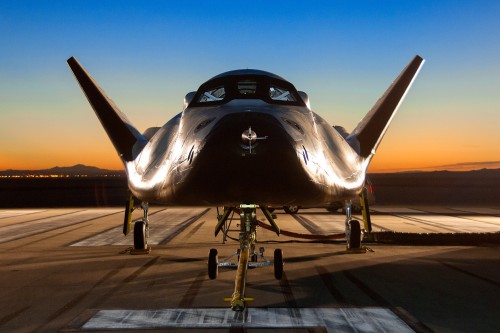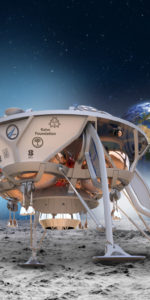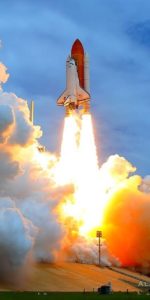
Sierra Nevada Corporation (SNC) may not have been awarded a multi-billion dollar commercial crew contract by NASA, but that isn’t stopping the company from moving forward with plans for their Dream Chaser “spaceplane”. Preparations are underway for the Louisville, Colorado-based company to launch the second phase of their Dream Chaser flight test program, significantly upgrading their Engineering Test Article (ETA) and simultaneously building an advanced composite orbital vehicle for an “upcoming suborbital and orbital flight regimen” beginning in 2016.
“The SNC team is readying the ETA in order to begin the second phase of atmospheric flight testing early next year and our strategic partner, Lockheed Martin, is leveraging best practices in tooling and composites to manufacture the first orbital Dream Chaser spacecraft,” said Mark Sirangelo, corporate vice president, SNC’s Space Systems, at the International Symposium for Commercial and Personal Spaceflight (ISPCS) in New Mexico. “Both efforts have been ongoing simultaneously and we are very pleased with the progress to date.”

SNC put their Dream Chaser ETA through its first free flight Approach and Landing test, or ALT-1, at NASA’s Armstrong Flight Research Center in southern California nearly two years ago, and the test went about as good as SNC could have hoped for, until it came time to land. When the command was given to deploy its landing gear, only two of its three gear deployed, causing the ETA to skid off the runway and sustain minor structural damage. The problem was blamed on a mechanical issue with the specific landing gear, rather than something related to bad software (none of the primary systems that gave the commands that control the flight failed or had any problems).
“The 99% of the flight that we really wanted to get – which was does this vehicle fly, is it able to be controlled, does the software work, can we autonomously fly the vehicle in to approach and land on a runway – all that was 100% successful,” said Sirangelo. “In fact, we probably performed better than the original test standards were meant to be.”
SNC says they have made significant structural and systems improvements to the ETA, including the composite wings and aeroshells, and invested heavily in maturing the vehicle’s orbital avionics, guidance navigation and control, the flight software, and employed a number of new processes, all of which will be used on the orbital vehicle as well. Finally, the advanced orbital Thermal Protection System (TPS) was installed on the ETA skid in order to do advanced testing of the actual orbital TPS.
“The Dream Chaser ETA is currently scheduled to arrive at Armstrong Flight Research Center in early 2016 in order to begin the second phase of atmospheric flight test,” says Sirangelo.
Flight tests from Armstrong would see the ETA dropped from a helicopter, same as the company’s ALT-1 two years ago. At this point a 2017 orbital flight test expectation is more realistic.
Sirangelo stresses SNC will be ready for contractual orbital flights for NASA and others in 2018, and the company has already contracted with ULA for Dream Chaser’s first Atlas-V rocket some time ago. At the time SNC had scheduled a Nov. 1 2016 launch date for the first orbital flight test, but that was dependent on being awarded a NASA contract, which did not happen, and therefore put SNC’s Dream Chaser development temporarily on hold while the company brainstormed how to move forward without NASA’s money.
In parallel to the ETA upgrade, Lockheed Martin is utilizing their knowledge of composite manufacturing from the Skunk Works (its advanced development programs division) to build SNC’s first Dream Chaser orbital vehicle, and they recently completed the orbital vehicle’s cabin assembly.
According to SNC, “this assembly is the largest high-temperature unitized structure ever fabricated at U.S. Air Force Plant 4. The assembly utilized three-dimensional woven joints, to integrate internal frames with external carbon skins in a single co-bond operation, meaning nearly all fasteners on this critical cabin assembly are eliminated. This state-of –the-art approach to design and manufacturing is a highly efficient and affordable design solution.”
WATCH: Dream Chaser’s First Free Flight Test
Its first orbital flight test(s) will be autonomous, no crew, but operational contracted missions with crew and/or cargo have not manifested yet. NASA’s Commercial crew Program dealt the company a big blow when they passed Dream Chaser for SpaceX and Boeing capsules for NASA’s crew transportation needs to and from the International Space Station (ISS), but there is still a lot of interest in Dream Chaser from the aerospace and aviation communities, and not just here in the United States. Both the European Space Agency (ESA) and the Japan Aerospace Exploration Agency (JAXA) have expressed interest in Dream Chaser’s capabilities as well, among others.
The fact is the spacecraft’s unique lifting-body winged design offers numerous potential applications that no other existing spacecraft can. Dream Chaser’s ultimate goal is to provide commercial services to a broader commercial market, rather than relying exclusively on NASA for contracts that may or may not come, and the company recently launched a new “Dream Chaser-Preferred Landing Site Program” to work with spaceports and commercial airports to become designated landing sites for Dream Chaser.
“Dream Chaser is poised to lead the commercial space industry in reusable, low-Earth orbital flight,” said Sirangelo. “The benefits of multiple landing sites would be significant to both the landing site community and to the Dream Chaser network of domestic and international partners. With each Preferred Landing Site designation, comes a greater opportunity to make commercial space an accessible reality.”
SNC is also hoping to secure an upcoming NASA space station resupply contract, Commercial Resupply Services 2 (CRS-2), where the company would fly an unmanned cargo-only version of the Dream Chaser with foldable wings for encapsulation in a payload fairing to launch atop ULA’s Atlas-V rocket and ESA’s Ariane-V rocket. NASA’s CRS-2 contract is valued at between $1 billion and $1.4 billion per year, with CRS-2 services being required from 2017 through 2024.
“Upon completion, the Dream Chaser orbital vehicle will be the most advanced composite structure ever built. We look forward to Dream Chaser becoming the world leader in this area and to its first orbital flight,” said Sirangelo.
WATCH: SNC Debuts Dream Chaser Cargo Craft for NASA CRS-2 Contract
Be sure to “Like” AmericaSpace on Facebook and follow us on Twitter: @AmericaSpace
.






It’s such a beautiful vehicle and I wish them well. It wasn’t clear how definite going orbital in 2016 will be. Any more info?
Amazing they can proceed forward minus a multi-billion award.
What they’re going forward with for the drop test still has a pay-off, because it will complete their remaining CCiCap milestone.
It’s encouraging that they’re still working and moving forward rather than packing it in.
Hi Ken,
They are not going orbital in 2016. They will drop the engineering test article from a helicopter in 2016. They have quite a way to go before the flight article flies.
I dearly hope they are successful and hope that the can accelerate their program to achieve manned flight ASAP!
A couple of years ago it was reported that they had already purchased a flight on an Atlas for 2016. As the article states, a 2017 launch is looking more probable now.
It is in some ways what the original space shuttle should have been- even though returning to LEO after having been to the Moon was a huge mistake.